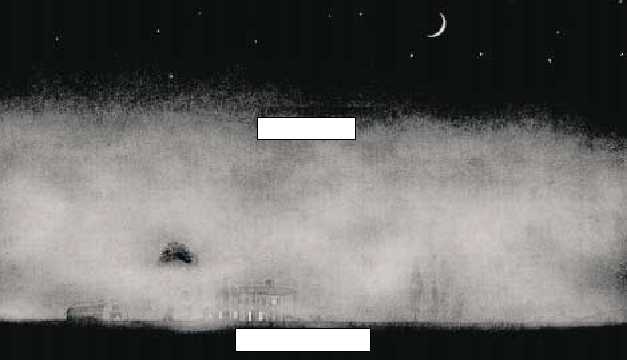air drainage (gravity induced, downslope flow of
relatively cold air) may be enough to prevent fog
formation, or a sudden shift in the wind direction may
cause fog to cover an airfield.
The temperature to which air must be cooled, at a
constant pressure and a constant water vapor content, in
order for saturation to occur is the dew point. This is a
variable, based upon the amount of water vapor present
in the atmosphere. The more water vapor present, the
higher the dew point. Thus, the dew point is really an
index of the amount of water vapor present in the air at a
given pressure.
Temperature and dew point may be made to
coincide either by raising the dew point until it equals
the temperature of by lowering the temperature to the
dew point. The former results from the addition of
water vapor to the air by evaporation from water
surfaces, wet ground, or rain falling through the air. The
latter results from the cooling of the air by contact with
a
cold
surface
underneath.
There
are
several
classifications of fog: radiation fog, advection fog,
upslope fog, and frontal fog.
RADIATION FOG.—Radiation
fog,
which
generally occurs as ground fog, is caused by the
radiation cooling of Earth’s surface. It is primarily a
nighttime occurrence, but it often begins to form in the
late afternoon and may not dissipate until well after
sunrise. It never forms over a water surface. Radiation
fog usually covers a wide area.
After sunset, Earth receives no heat from the Sun,
but its surface continues to reradiate heat. The surface
begins to cool because of this heat loss. As Earth cools,
the layer of air adjacent to the surface is cooled by
conduction (the transfer of heat from warmer to colder
matter by contact). This causes the layer near Earth to
be cooler than the air immediately above it, a condition
called an inversion. If the air beneath the inversion layer
is sufficiently moist and cools to its dew point, fog
forms. (See fig. 5-2.) In case of a calm wind, this
cooling by conduction affects only a very shallow layer
(a few inches deep), since air is a poor conductor of
heat. Wind of low speed (3 to 5 knots) causes slight,
turbulent currents. This turbulence is enough to spread
the fog through deeper layers. As the nocturnal cooling
continues, the air temperature drops further, more
moisture is condensed, and the fog becomes deeper and
denser. If winds increase to 5 to 10 knots, the fog will
usually thicken vertically. Winds greater than 10 knots
usually result in the formation of low scud, stratus, or
stratocumulus.
After the Sun rises, Earth is heated. Radiation from
the warming surface heats the lower air, causing
evaporation of the lower part of the fog, thereby giving
the appearance of lifting. Before noon, heat radiated
from the warming surface of Earth destroys the
inversion and the fog evaporates into the warmed air.
Radiation fog is common in high-pressure areas where
the wind speed is usually low (less than 5 knots) and
clear skies are frequent. These conditions permit
maximum radiation cooling.
5-7
AG5f0502
RADIATION
LAND COOLING
Figure 5-2.—Radiation fog.

